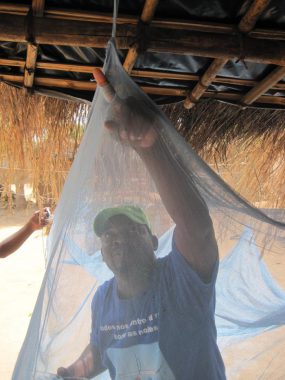Africa Field Program
Who We Are
Based at the CDC-Kenya office in Nairobi, the Africa Field Program in the Division of Global Migration and Quarantine (DGMQ) oversees the planning for and quality of medical screening of US-bound immigrants and refugees.
What We Do
About 20,000 refugees and 50,000 immigrants are admitted annually into the United States from Africa. The Africa Field Program helps prevent the importation of infectious diseases of public health significance by:
- Overseeing the required medical examination of refugee and immigrant visa applicants before they travel to the US.
- Helping to prevent, detect, and respond to outbreaks of disease in targeted refugee populations.
Where We Work
US refugee admissions from Africa by Processing Country, 2017

How We Work Together

A man inspects a mosquito net. Splenomegaly is often caused by chronic, repeated malaria infections.
The program collaborates with other CDC programs, as well as the US State Department Bureau for Population, Refugees, and Migration, and US Consulates; the International Organization for Migration (IOM); the United Nations Refugee Agency (UNHCR); foreign ministries of health; and nongovernmental organizations providing healthcare and preventive services to refugee populations.
Splenomegaly among US-bound refugees in Uganda: The Africa Field Program collaborated with IOM for a clinical evaluation of the causes of splenomegaly among US-bound refugees from the Kyangwali settlement in Uganda. Splenomegaly is challenging to diagnose and treat, and it appears to be an emerging, highly prevalent condition among Congolese refugees. Further investigation into the cause and management of splenomegaly in this population is needed.
Evaluation of diagnostic tests for rotavirus: The Africa Field Program partnered with UNHCR, the International Rescue Committee, IOM, and the Kenya Medical Research Institute (KEMRI) to evaluate the field performance of ImmunoCard Stat® rapid diagnostic tests for rotavirus in the Dadaab refugee camp. These point-of-care tests were found to be useful in detecting rotavirus outbreaks in resource-limited settings.
Cholera response in the Dadaab refugee camp: In 2016, the Africa Field Program worked with the CDC Division of Global Health Protection, KEMRI, UNHCR, and the Kenya Ministry of Health to provide technical assistance such as laboratory testing during the largest outbreak of cholera in the history of the Dadaab refugee camp. The program continues to monitor the extent of multidrug-resistant Vibrio cholerae in Dadaab and the Kenyan- Somali border region.
Program in Action
In 2013, DGMQ and partners began implementing an overseas presumptive treatment program for intestinal parasites and a cost-effective vaccination program targeting 13 vaccine-preventable diseases in US-bound refugees. As of 2017, vaccination activities have been established in 20 countries, including 9 in Africa. Since 2013, more than 177,000 refugees have been vaccinated overseas, helping to protect refugees and prevent the introduction and spread of disease in the United States.
In response to a 2015 malaria outbreak in Kakuma refugee camp in Kenya, the Africa Field Program issued recommendations in 2016 to reduce the risk of malaria among refugees who had been transferred temporarily from Dadaab refugee camp to Kakuma refugee camp and to facilitate interviews conducted as part of US Refugee Admissions Program processing. These recommendations included voluntary malaria chemoprophylaxis for refugees interviewed in Kakuma, diversion of pregnant women and babies weighing less than 5 kilograms to Nairobi, and enhanced febrile illness surveillance among this population upon their return to Dadaab to reduce risk of exposure to the disease and to ensure rapid treatment if illness developed.